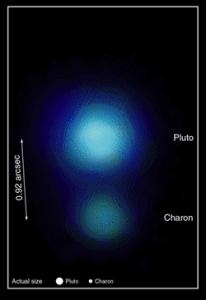New Horizons, the doughty spacecraft soon to be sent to Pluto, Charon and on into the Kuiper Belt, has been shipped from its birthplace — the Johns Hopkins University Applied Physics Laboratory (APL) in Laurel, MD — to NASA’s Goodard Space Flight Center in nearby Greenbelt. At Goddard, New Horizons will begin another round of pre-launch tests, with liftoff scheduled for next January.
What I hear from people associated with this project is that New Horizons is ready to go. As mentioned here earlier, APL’s David Dunham gave a talk about upcoming missions at the recent New Trends in Astrodynamics conference in Princeton. I had been concerned about the review process that New Horizons must undergo, required because it carries a radioisotope thermoelectric generator (RTG) that produces energy from fissionable materials. The final environmental impact statement produced by this process is due in the summer, with final NASA decision on the mission in the fall. But when I talked to him at the conference banquet that night, Dunham seemed to have no apprehensions about New Horizons receiving final launch approval.
 Meanwhile, the spacecraft has been through a rough week in the APL vibration test lab where it was shaken aboard a large table to simulate the liftoff ride, which will be on an Atlas V launch vehicle. Having passed these tests, the probe will be subjected to deep space conditions, receive balance and alignment testing in a series of spin situations, and made to undergo noise simulations that look for vibration problems during the liftoff phase.
Meanwhile, the spacecraft has been through a rough week in the APL vibration test lab where it was shaken aboard a large table to simulate the liftoff ride, which will be on an Atlas V launch vehicle. Having passed these tests, the probe will be subjected to deep space conditions, receive balance and alignment testing in a series of spin situations, and made to undergo noise simulations that look for vibration problems during the liftoff phase.
Image: The excellent quality of its 8.3-meter primary mirror and the stability of the atmosphere above Mauna Kea, Hawaii, allowed the Subaru Telescope to provide clearly separated images of Pluto and Charon using its Cooled Infrared Spectrograph/Camera. This image is produced from three 2-second exposures taken through infrared filters on June 9, 1999. Credit: Dale P. Cruikshank, Catherine de Bergh, Sylvain Dout, Thomas R. Geballe, Tobias C. Owen, Eric Quirico, Ted L. Roush and Bernard Schmitt; published in Science (vol. 285, p.1355), 1999.
The launch window is 35 days, opening on January 11. This is designed to be a fast mission; in fact, New Horizons, boosted by the Atlas V and a STAR-48B kick motor, will reach the orbit of the moon in less than nine hours after launch, entering Jupiter space for a flyby just 13 months later. When it encounters Pluto in 2015, New Horizons will be about 3.1 billion miles from Earth, and its extended mission would take it into the Kuiper Belt for a possible encounter with one or more of the icy worlds in this trans-Neptunian region.
We don’t know exactly what we’ll find on Pluto, but APL has an interesting feature comparing Pluto to Triton, Neptune’s enigmatic moon. Both objects are thought to have interiors composed of water ice over a rocky core, with non-water ices like methane, carbon dioxide and nitrogen present on their surfaces. Like Pluto, Triton is seen by many astronomers as a Kuiper Belt object, one disrupted by a giant impact in the past that formed the moon Charon (just as Triton may have struck another Neptunian satellite as it wandered into the planet’s gravity well). In both cases, the ensuing redistribution of mass may have produced some exceedingly interesting surface features.

